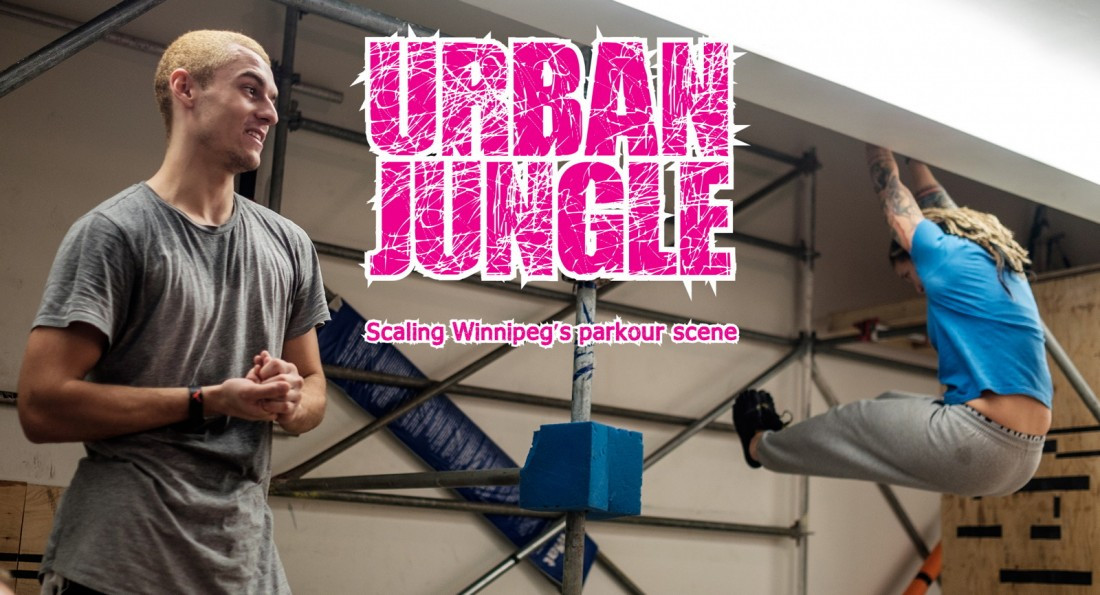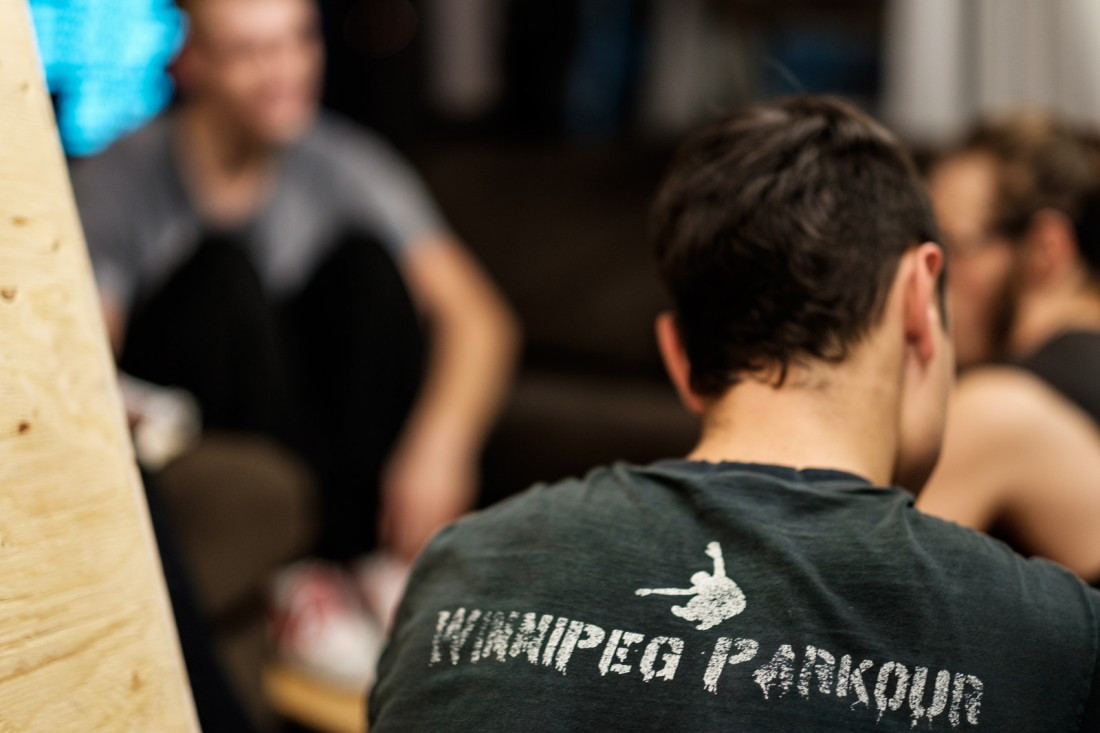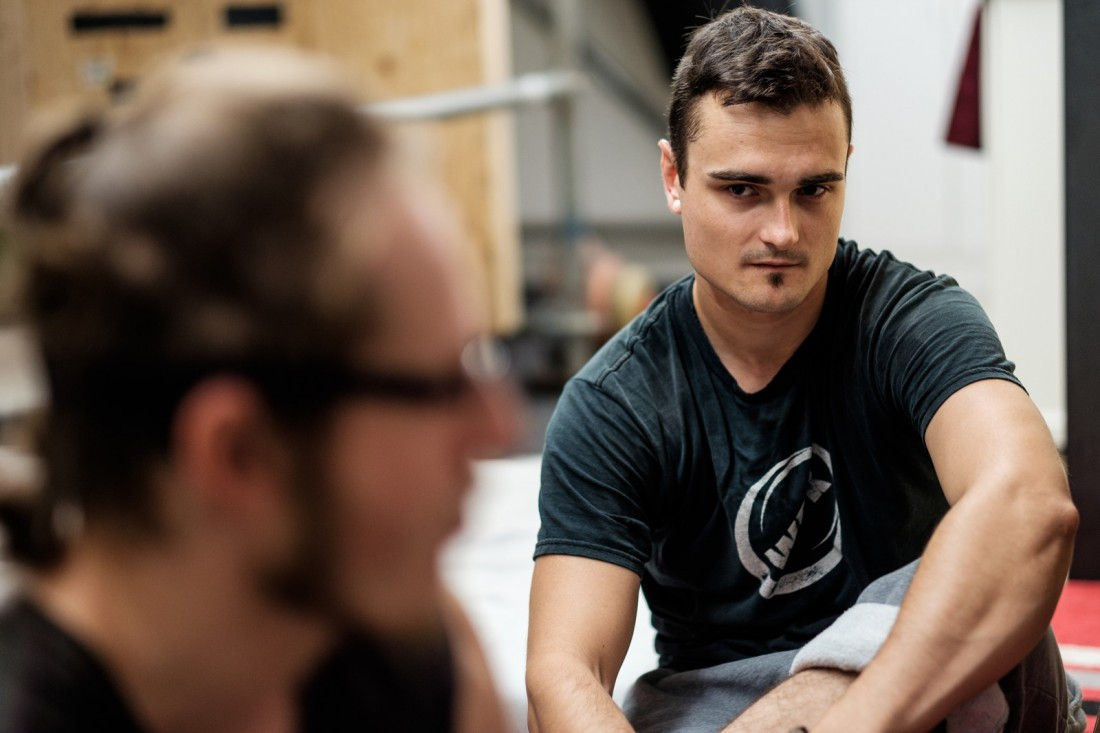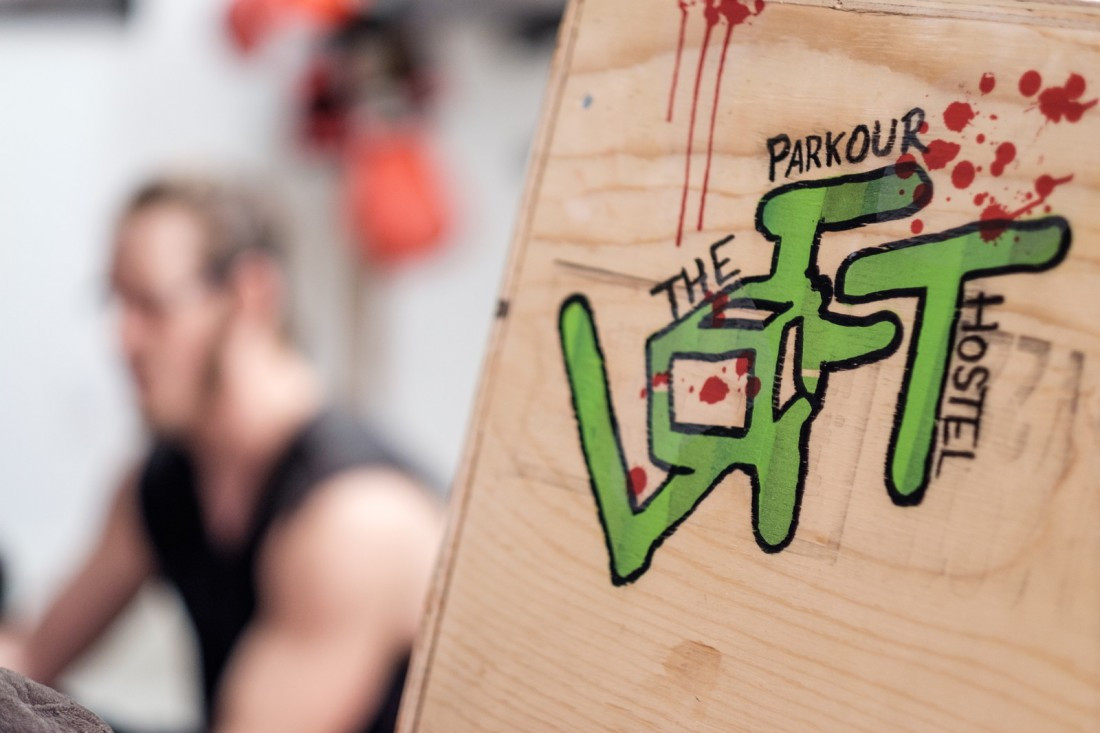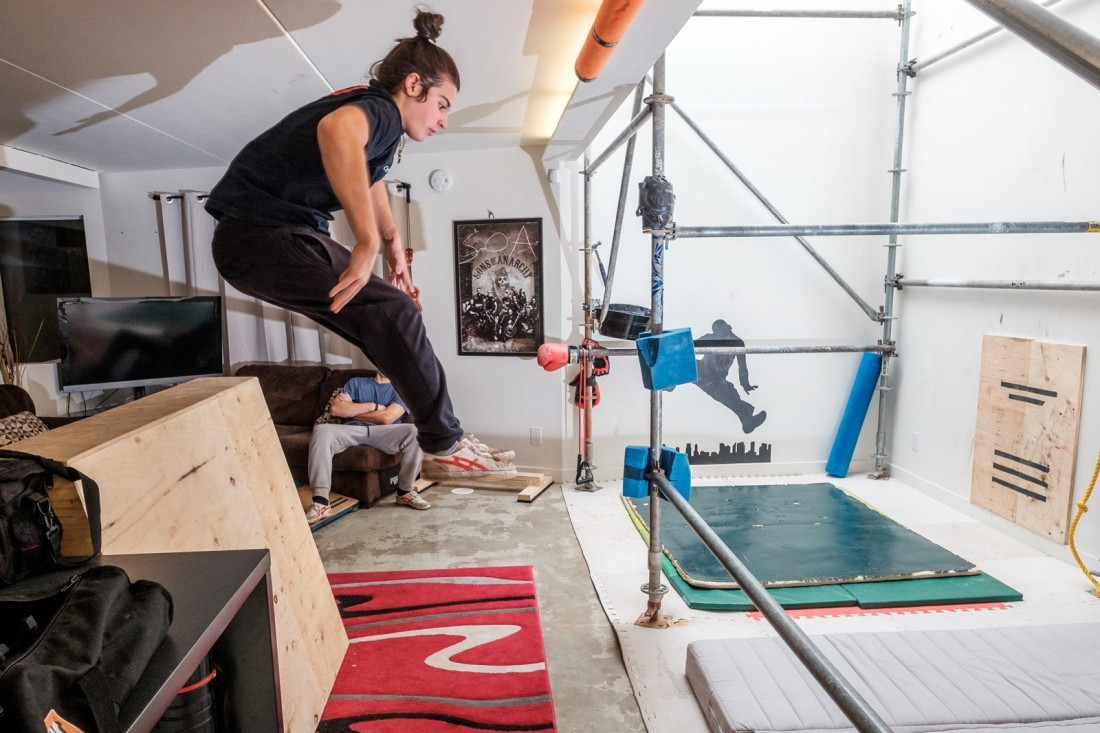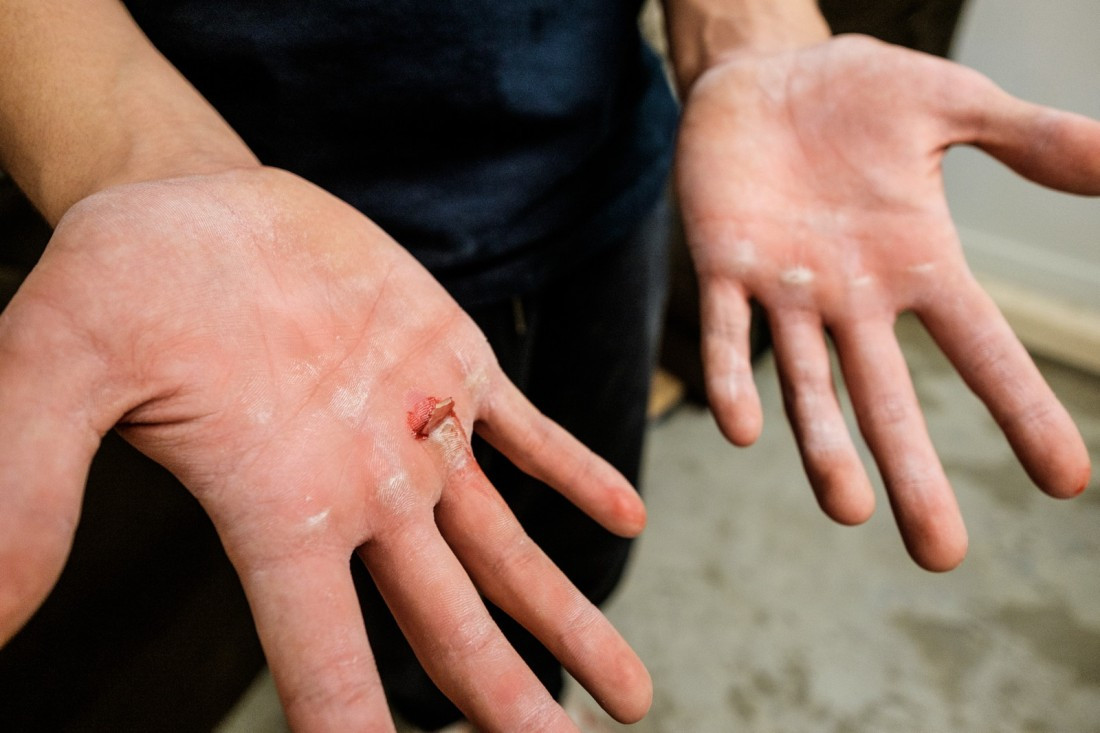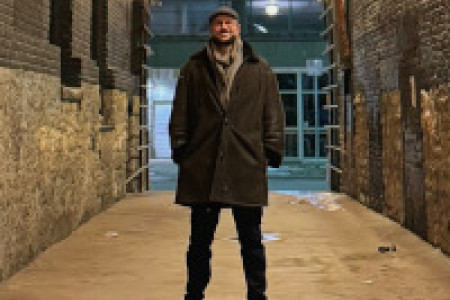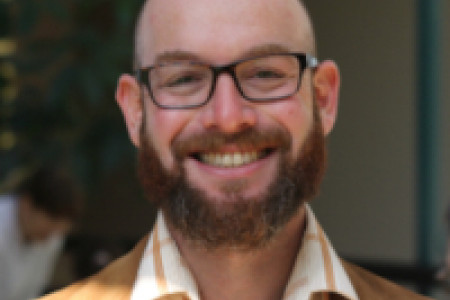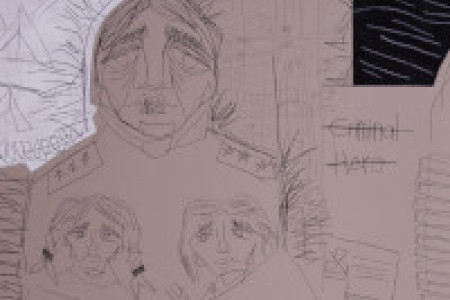Urban jungle
Scaling Winnipeg’s parkour scene
Marc Selby demonstrates a shoot through to precision in his homemade training area.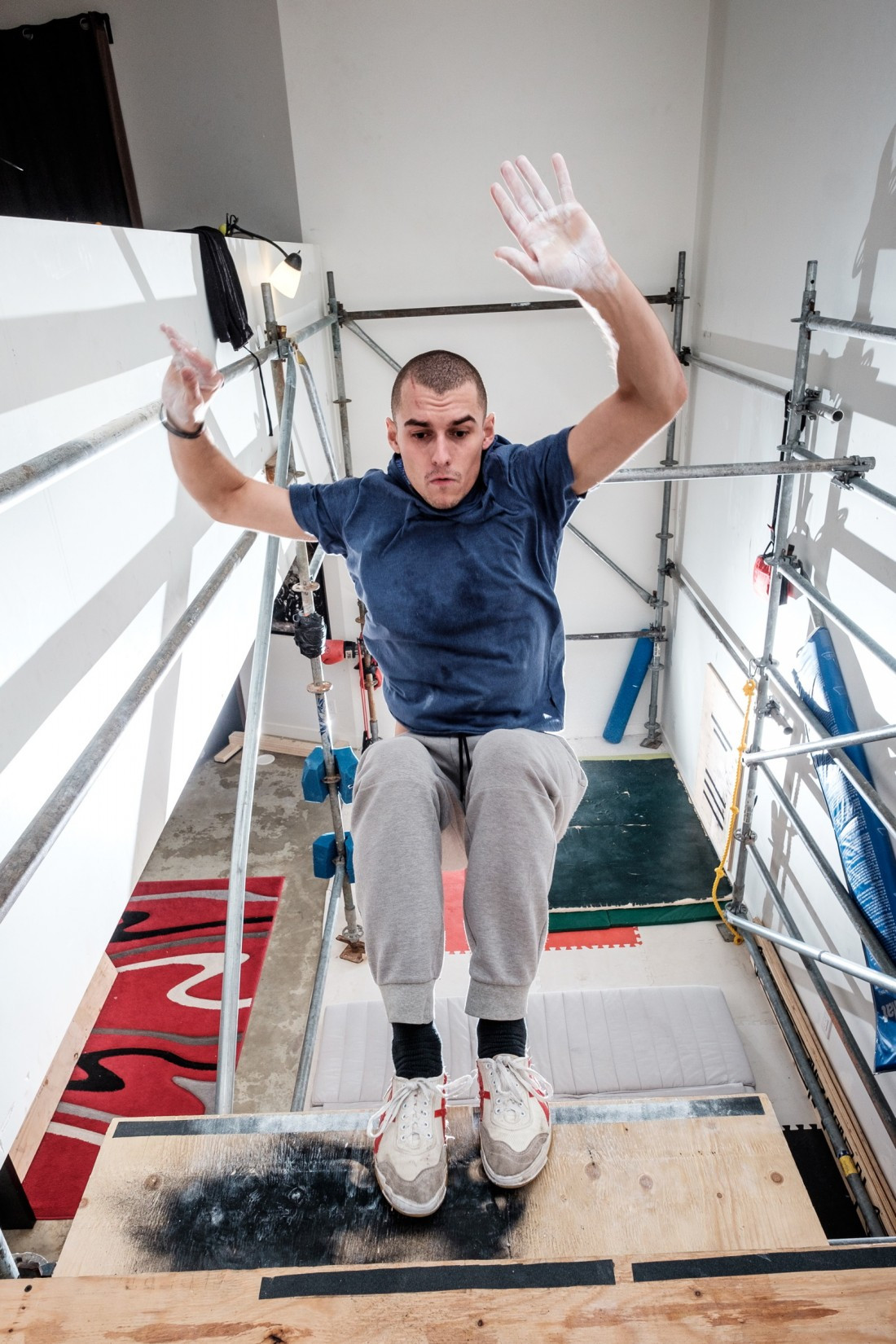
Michael Bileski, 27, says there are several different parkour (PK) styles but that it’s basically broken down into two groups.
“There’s a difference between efficient versus aesthetic movements,” he says. “You’ve got something that’s more practical, that’ll get you from point A to B, and then you’ve got something that’s more eye-catching, for fun, that kind of stuff.”
Parkour is a sport that can safely be described as young. But since its establishment, PK culture has burst onto the scene in cities across the world.
For some, PK is synonymous with scaling multi-storey buildings and evading law enforcement. It’s impossible to watch videos of guys hanging off of a crane with one hand without thinking about the dangers involved.
Watching the stunts on a screen is sure to induce sweaty palms and at least minor anxiety.
But the roots of PK are closer to the ground. The lifestyle isn’t just about pulling off mind-blowing stunts and getting fit, it’s also about community, physical and mental fitness and exploring your own backyard.
Marc Selby, 23, has been involved in Winnipeg’s PK scene since it started (between 2003 and 2005). Selby didn’t know what PK was when he started jumping between rooftops and doing flips over benches until he met some of Winnipeg’s “first gen” PK group.
Christie Brenan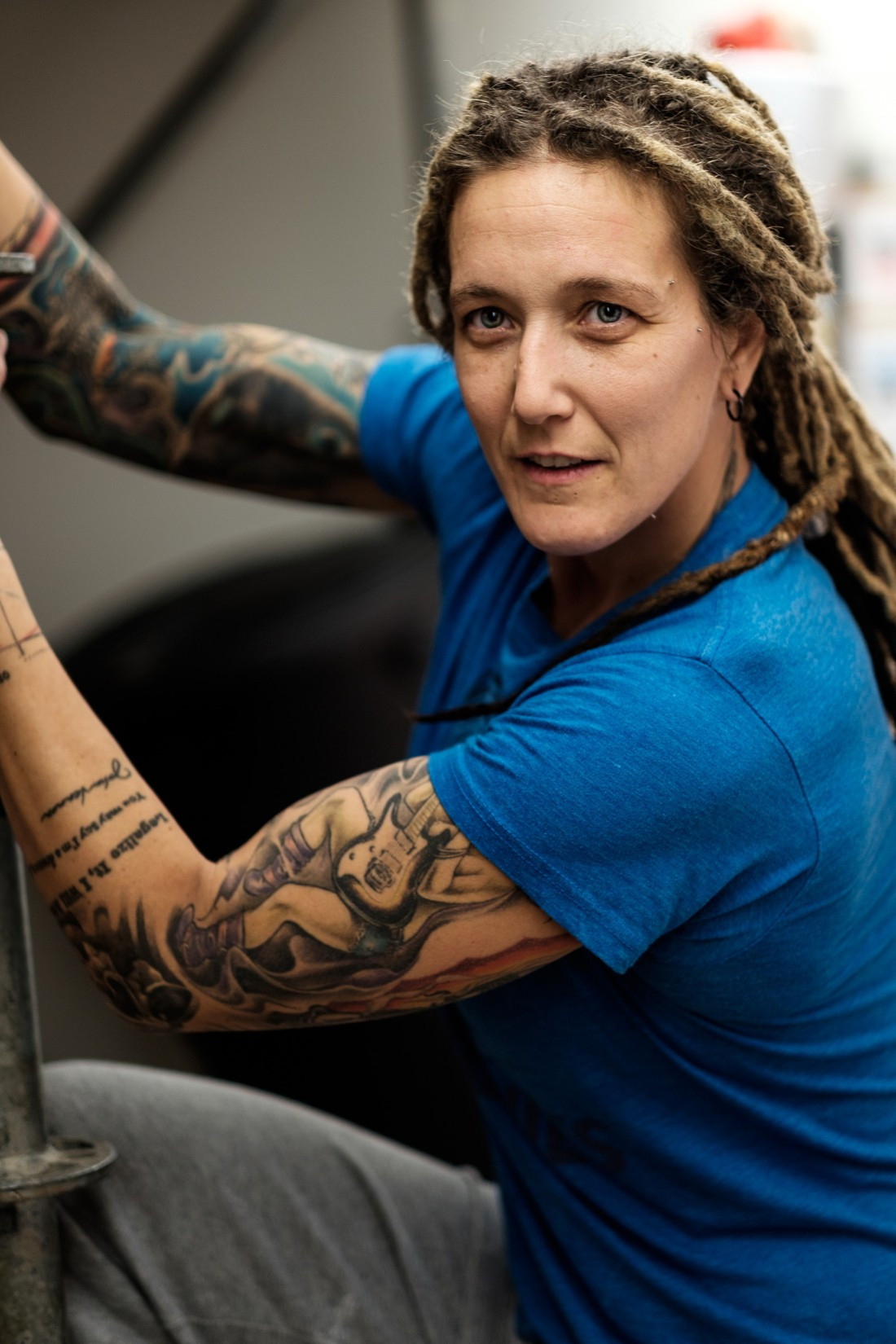
Most nights of the week, Selby’s apartment is full of visiting friends who make use of the place’s dynamic training space. One half of Selby’s main floor is set up with a series of scaffolding, rings, ropes, ramps and foam pads. If you can imagine jungle gym day at your elementary, you’re not far off.
Christie Brenan, 41, said that for her PK started three years ago with a simple hop forward in her first PK training class.
“The teacher said you are doing that and I said no, I’m not doing that for the life of me,” Brenan recalls of the metre-long jump forward on the ground. “Just the jump from here to there… and then I’m doing it. Progression is what it is.”
The modern version of parkour originated in a couple of suburbs outside of Paris, France in the 1980s. According to Selby, there are 23 basic movements in PK, and every single one was first done in the neighbourhoods of Lisses and Evry.
“So everyone wants to do that pilgrimage,” Selby says. “It’s like, hey, I’m doing a cat leap, 100th cat leap I’m doing in my life, but I’m doing it in the first spot that it was ever done.”
Even though Selby and his friends haven’t made it to France yet, they have explored PK in other cities. Selby recently visited Lisbon, Portugal and attended a pro jam in Cambridge, United Kingdom. His friend Val Blant just got home from a two week trip to Madrid, Spain and Rome, Italy.
“It’s amazing. It’s really much more suitable to parkour,” Blant says. “We have to be much more creative here. There it’s just obvious. You get on a roof, you run for three kilometres.”
While the group looks forward to getting a bird’s-eye view on new and exotic cities, they all agree that living in Winnipeg – even with months of snow on the ground – isn’t a bad thing for staying in the PK game.
A boxing glove is mounted on the end of scaffolding to provide protection for participants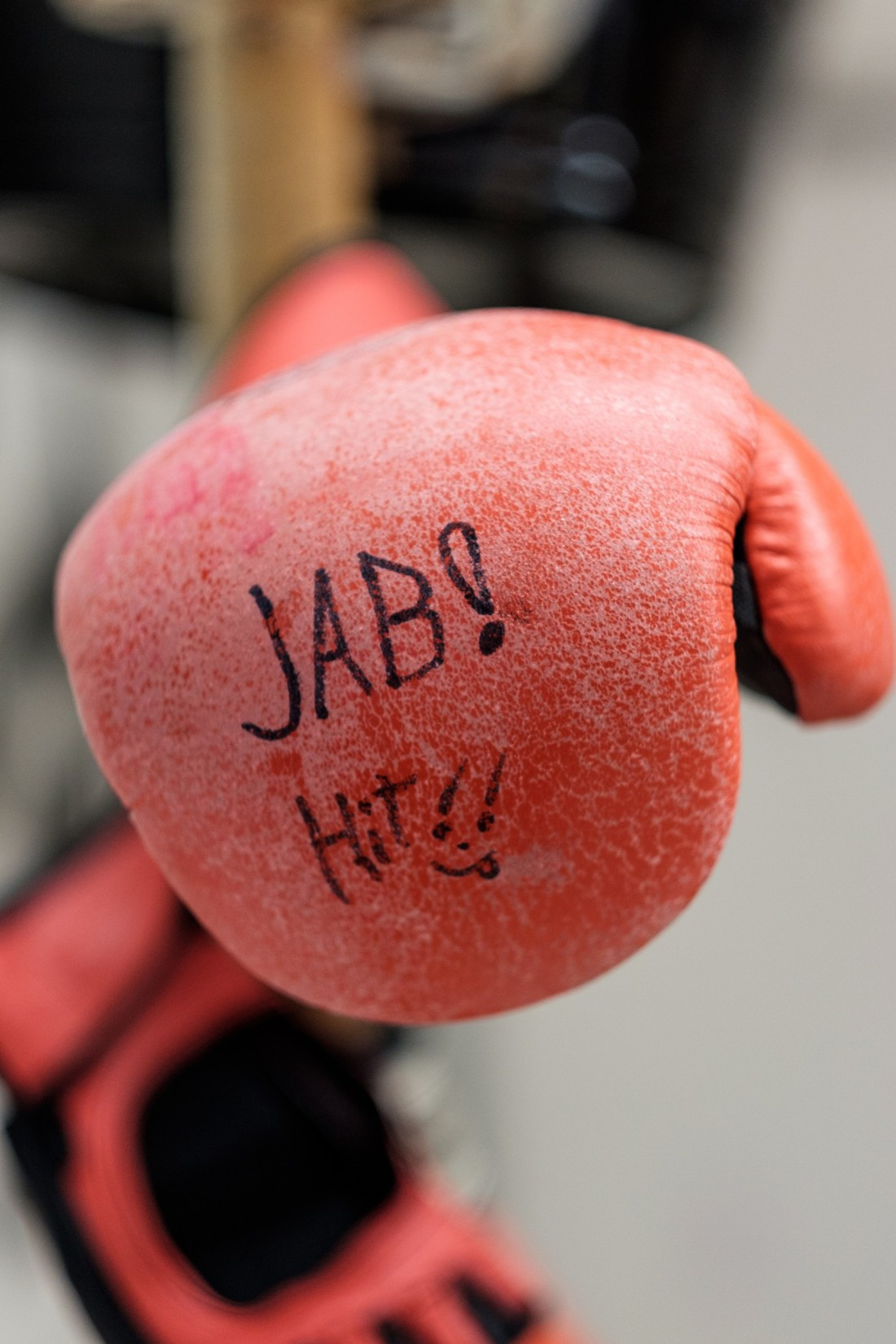
“The thing is, no matter how good of a spot you have, if that’s where you live, you’re always going to get bored of it because that’s where you’ve been training for 10 years,” Blant, 35, says.
One of Blant’s goals in PK training is to be able to get away if someone attacks or chases him. He trains in tight-fitting dress pants because he knows that if something does happen, he probably won’t be wearing workout clothes.
He and Selby agree that winter has the potential to slow them down, especially when compared to places that are warm year-round. But the down-time is not unwelcome.
“We have - 40 C weather but we have gymnastics gyms everywhere, we have rock-climbing gyms, track and field gyms,” Selby says.
“I could squat all winter and make my parkour that much better next spring. Most guys in parkour have to utilize breaks anyway for physiotherapy and things like that… there’s a reason we pump out some of the sickest dudes ever.”
And while the architecture might not be as conventionally beautiful or unusual as it is in other cities, it forces the group to get creative about their training.
“Sometimes you think you’ve run out of stuff and then you go travel and you come back and whoa – I did not run out of stuff,” Selby says.
“Every year The Forks changes, every year the U of M changes. For a while I was running into these plateaus and getting jealous and thinking I wish I lived in this place and then I realized that regardless of where you are, there’s something to be working on.”
Val Blant discussing parkour.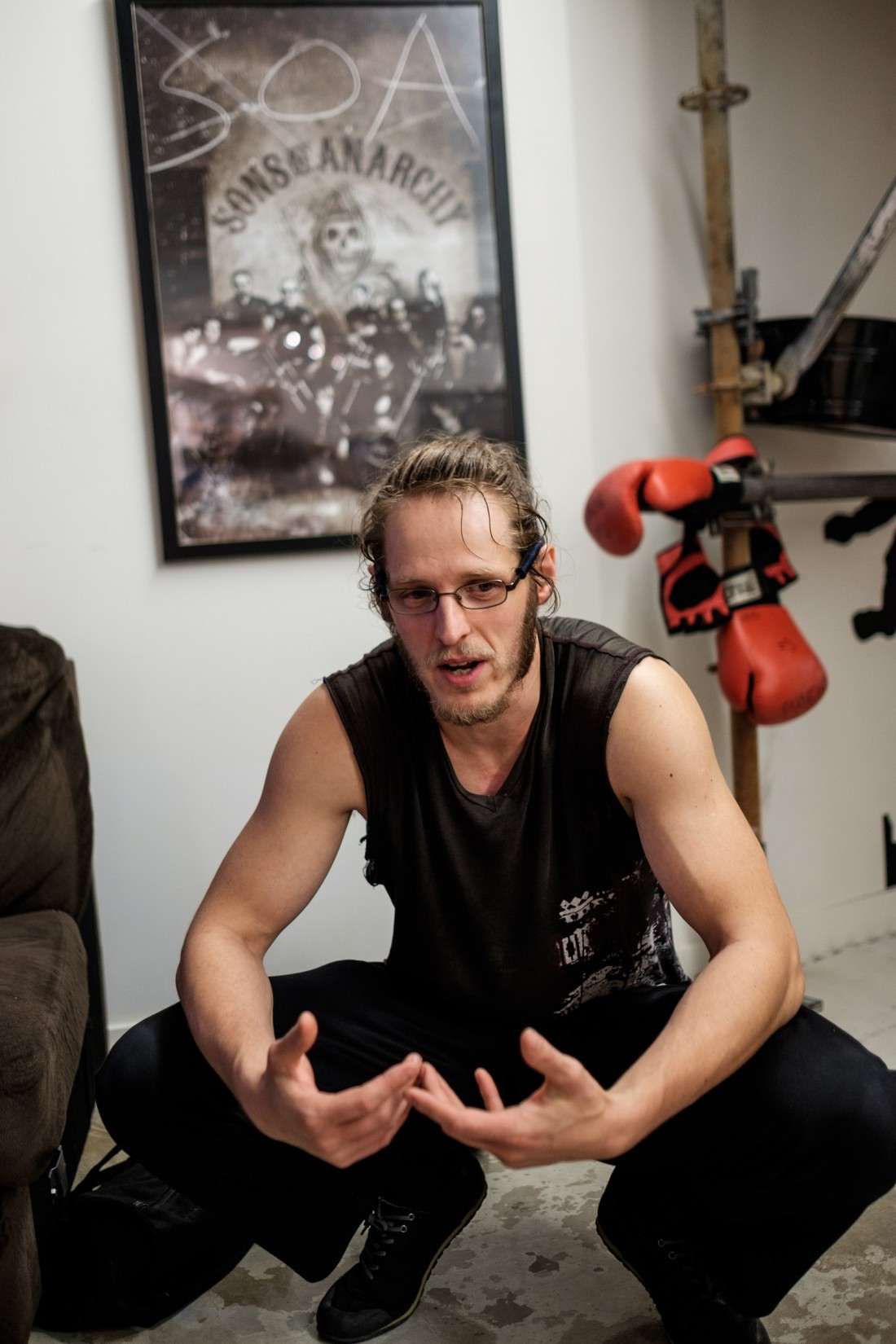
Free climbing and freerunning are sometimes referred to as PK and other times they are considered separate movements. Climbing involves scaling buildings and getting height, while running is about moving in a horizontal direction – this could be above-ground as well but doesn’t have to be.
Law officials have reportedly had issues with PK in the city with regards to trainer safety, but true PK practice puts safety first.
“It’s not about adrenaline,” Blant says. “If you’re feeling adrenaline or feeling nervous, you shouldn’t be doing it.”
All those videos of people hanging off the side of a building? The athletes who perform those stunts have to be cool as a cucumber. Selby, Blant, Brenan and Bileski have never suffered more than an a sprained ankle in multiple years of training, making it safer than most sports. But it’s all about knowing your body and your environment.
“I’ve separated my shoulder, I’ve pretty much torn off my achilles tendon on a motorcycle,” Brenan says. “I do PK three times a week… never been injured.”
The group also has a strong “leave no mark” philosophy when they’re out in the city. “If we ever break a window or something, the community rallies together and raises money to fix it,” Blant says.
While PK has created some tension with the law in some places, the local PK group has established an understanding between themselves and police officers, who they always make a point of talking to.
“We just say hey, we’re not here to steal a television,” Blant says.
Marc Selby demonstrates a precision.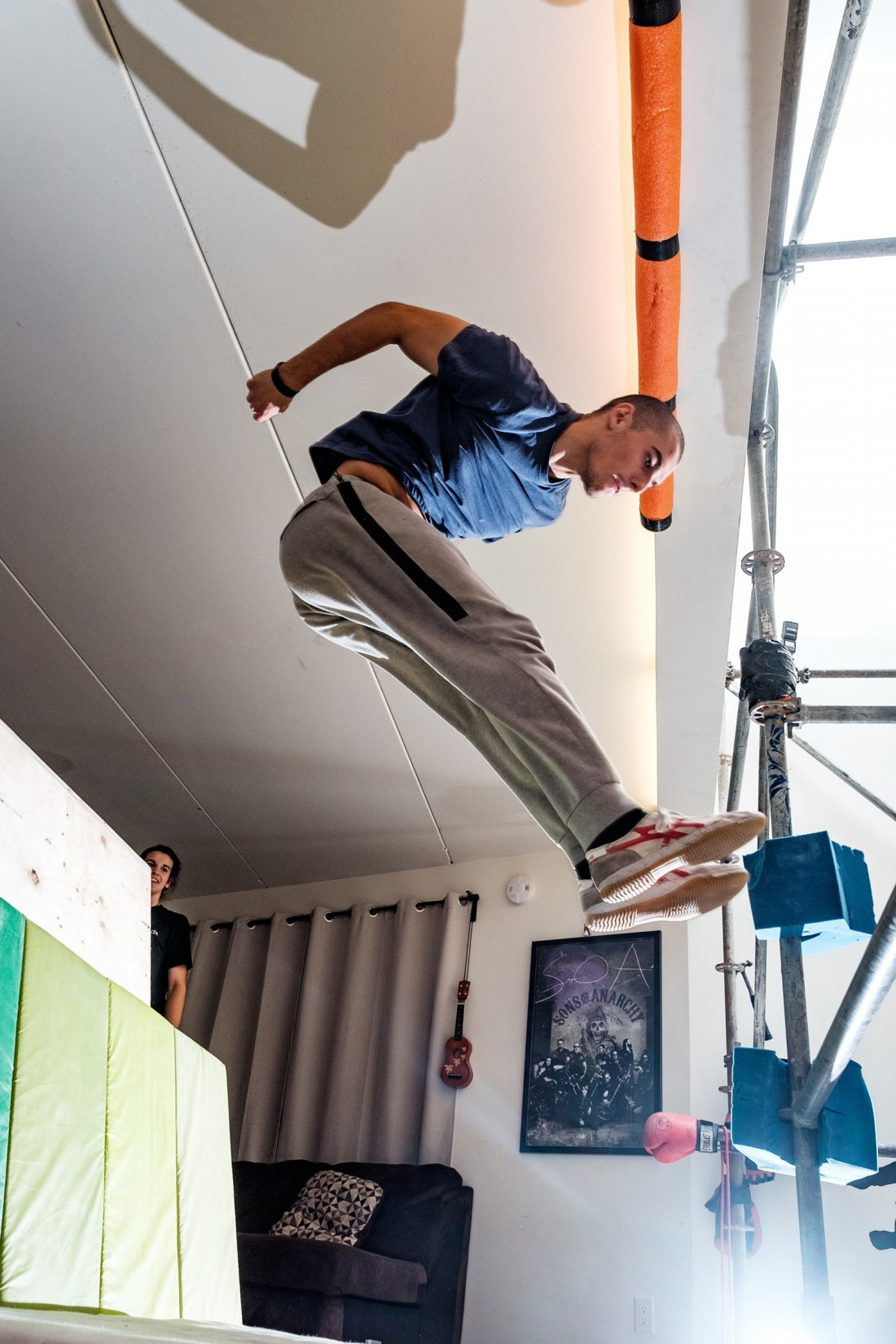
“We’re kind of part of something big,” Selby says.
Back in Selby’s apartment, he and his friends leap around the room, cheer each other on and commiserate as a group when someone misses their landing. The sense of community and support is palpable, and it isn’t surprising to leave to the calls of, “come back anytime! We’ll train you!”
For this group – and any that subscribes to the PK philosophy – community, harmony and living to the max is the driving force. Selby and his friends will put up travelling PK athletes and when they travel the world, fellow trainers will accommodate and show them around for little to no cost.
“There are PK competitions, which is fine, but it goes against one of the main beliefs which is that PK is non-competitive,” Blant says. “There’s just you and your environment.”
When he’s not at his tech job, Blant spends hours training and he says it’s been one of the biggest changes he’s ever made. He’s found good friends in the community, gotten into shape and changed his mental outlook. For him, PK has been literally life-changing.
Blant even argues in favour of exposing children to PK.
“We strive to help children and adults from all walks of life reconnect with their innate love of movement, connect with their surroundings, and experience the full potential of what their bodies and minds can do,” he wrote in an article titled “Social Impact of Parkour.”
Mark Selby chalks up before demonstrating some parkour techniques.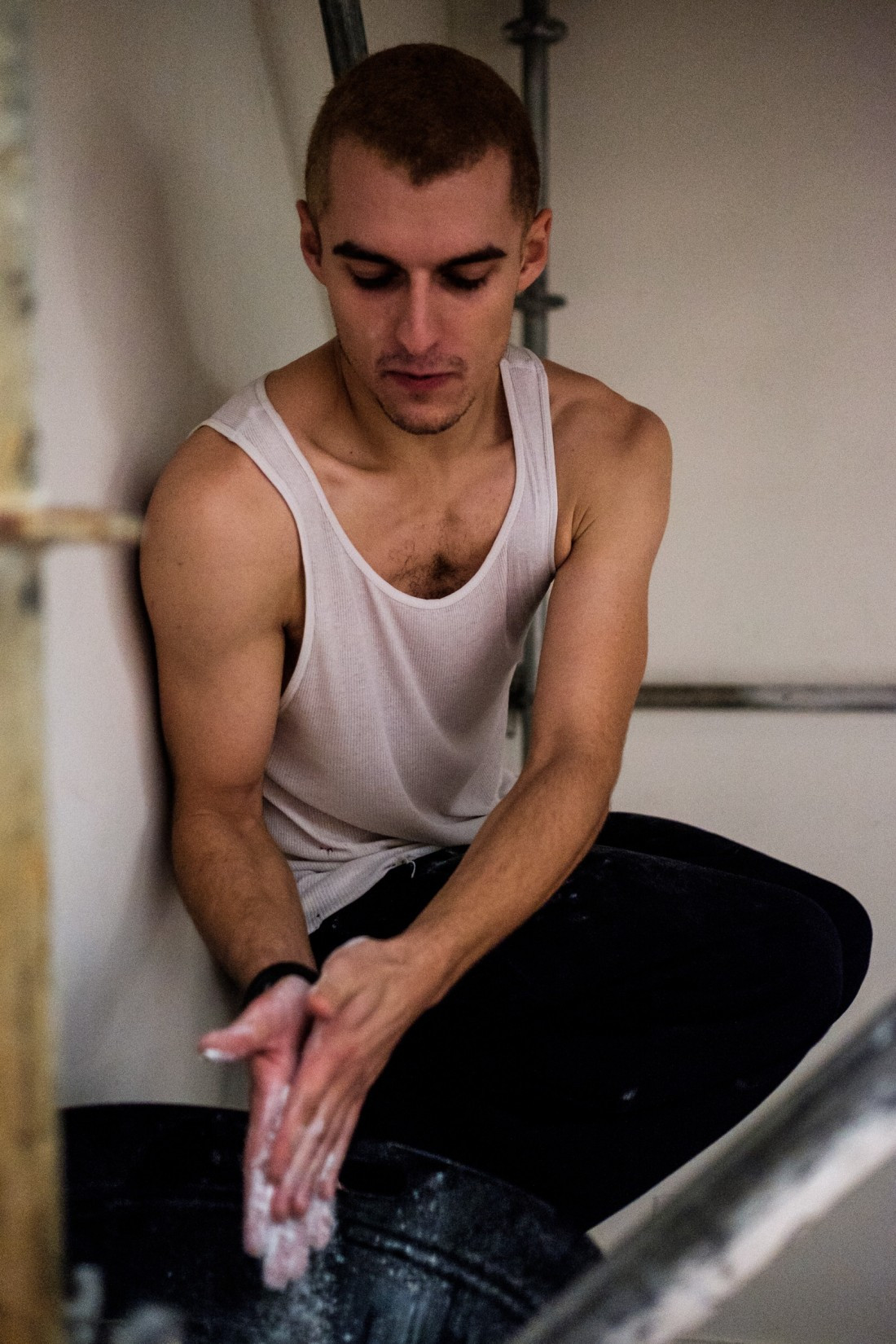
For those who consider the movements dangerous, allowing kids to train seems harmful. But many parents are ready to send kids off to hockey, soccer and football where broken noses and worse are common.
“I feel bad for these kids,” Brenan says. “Getting up at five in the morning, walking around with black eyes. It’s really violent, some of these sports.”
Another plus is that PK is one of the least expensive sports there are, with only one required piece of equipment – a pair of rubber-soled shoes.
Even if you missed out on the benefits of PK as a child, it’s never too late to get into the gym and learn a few moves. Selby says his 52-year-old mother recently came to one of his PK classes at Fantastic Gymnastics and surprised herself.
And regardless of age, PK reclaims the feeling of being a kid – that sense that anything can be climbed or swung from. It’s a reminder that the city and the world is a playground and how you use your body to move across that urban jungle – well that’s up to you.
Published in Volume 70, Number 11 of The Uniter (November 19, 2015)

